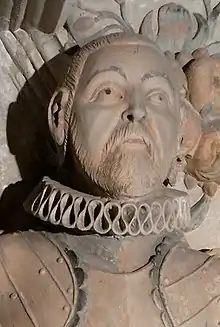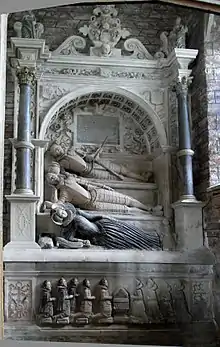Lord Edward Seymour (died 1593)
Lord Edward Seymour[lower-alpha 1] (c. 1528 – 2 May 1593), knight, of Berry Pomeroy, Devon, was Sheriff of Devon in 1583.[1] He was knighted by his father the Duke of Somerset on the battlefield of Pinkie on 10 September 1547.

Biography
Lord Edward Seymour was the eldest son (but not the main heir) of Edward Seymour, 1st Duke of Somerset (c. 1500 – 1552) by his first wife Catherine Fillol.[2] The paternity of Catherine's two sons was questioned by her husband after it was alleged that she had had an affair. This resulted in both her sons being excluded in 1540 from their inheritances and their claims to their father's dignities in favour of his children by his second wife, Ann Stanhope;[3] her eldest son succeeding his father as Duke of Somerset.
In June 1553 he received the manor of Berry Pomeroy, Devon, including Berry Pomeroy Castle.

Seymour married Margaret Walshe, a daughter and co-heiress of John Walshe (c. 1517 – 1572) of Cathanger,[2] Fivehead, Somerset, Justice of the Common Pleas in 1563, MP.[4] by whom he had one son, Sir Edward Seymour, 1st Baronet (d. 1613).
Monument in Berry Pomeroy church
A monument to Lord Edward Seymour survives in St Mary's Church, Berry Pomeroy, standing against the north wall of the north aisle of the Seymour Chapel. It was described by the architectural historian Nikolaus Pevsner (1952) as: "The figure carving astonishingly naive. To think that the children of Lord Protector Somerset were satisfied with this!"[5] Hoskins (1959) on the contrary called it "fine".[6] Writing in 1909, John Stabb described the monument thus:[7]
In the north wall of the chapel at the east end of the north aisle is a fine monument [...], erected to the memory of Lord Edward Seymour, the son of the Protector, who died in 1593, and of his son, Sir Edward Seymour, and his daughter-in-law, Elizabeth, daughter of Arthur Champernowne. The arch is ornamented with roses and pomegranates; beneath the arch lie the knights, clothed in plate armour, one above the other; below lies the lady, behind her head a cradle with a child in it, and at her feet a figure in a chair. On the panel beneath are the kneeling figures of the nine children, five male and four female.
Ancestry
| Ancestors of Lord Edward Seymour (died 1593) | ||||||||||||||||||||||||||||||||||||||||||||||||||||||||||||||||||||||||||||||||||||||||||||||||||||||||||||||||||||||||||||||||||||||||||||||||||||||||||||||||||||||||||||||||||||||||||||||||||||||||||||||||||||||||||||||||||||||||||||||||||||||||||||||||||||||||||||||||||||||||||||||||||||||||||||||||||||||||||||||||||||||||||||||||||||||||||||||||||||||||||||||||||||||||||||||||||||||||||||||||||||||||||||||||||||||||||||||||||||||||||||||||||||||||||||||||||||||||||||||||||||||||||||||||||||||||||||||||||||||||||||||||||||||||||||||||||||||||||||||||||||||||||||||||
|---|---|---|---|---|---|---|---|---|---|---|---|---|---|---|---|---|---|---|---|---|---|---|---|---|---|---|---|---|---|---|---|---|---|---|---|---|---|---|---|---|---|---|---|---|---|---|---|---|---|---|---|---|---|---|---|---|---|---|---|---|---|---|---|---|---|---|---|---|---|---|---|---|---|---|---|---|---|---|---|---|---|---|---|---|---|---|---|---|---|---|---|---|---|---|---|---|---|---|---|---|---|---|---|---|---|---|---|---|---|---|---|---|---|---|---|---|---|---|---|---|---|---|---|---|---|---|---|---|---|---|---|---|---|---|---|---|---|---|---|---|---|---|---|---|---|---|---|---|---|---|---|---|---|---|---|---|---|---|---|---|---|---|---|---|---|---|---|---|---|---|---|---|---|---|---|---|---|---|---|---|---|---|---|---|---|---|---|---|---|---|---|---|---|---|---|---|---|---|---|---|---|---|---|---|---|---|---|---|---|---|---|---|---|---|---|---|---|---|---|---|---|---|---|---|---|---|---|---|---|---|---|---|---|---|---|---|---|---|---|---|---|---|---|---|---|---|---|---|---|---|---|---|---|---|---|---|---|---|---|---|---|---|---|---|---|---|---|---|---|---|---|---|---|---|---|---|---|---|---|---|---|---|---|---|---|---|---|---|---|---|---|---|---|---|---|---|---|---|---|---|---|---|---|---|---|---|---|---|---|---|---|---|---|---|---|---|---|---|---|---|---|---|---|---|---|---|---|---|---|---|---|---|---|---|---|---|---|---|---|---|---|---|---|---|---|---|---|---|---|---|---|---|---|---|---|---|---|---|---|---|---|---|---|---|---|---|---|---|---|---|---|---|---|---|---|---|---|---|---|---|---|---|---|---|---|---|---|---|---|---|---|---|---|---|---|---|---|---|---|---|---|---|---|---|---|---|---|---|---|---|---|---|---|---|---|---|---|---|---|---|---|---|---|---|---|---|---|---|---|---|---|---|---|---|---|---|---|---|---|---|---|---|---|---|---|---|---|---|---|---|---|---|---|---|---|---|---|---|---|---|---|---|---|---|---|---|---|---|---|---|---|---|---|---|---|---|---|---|---|---|---|---|---|---|---|---|---|---|---|---|---|---|---|---|---|---|---|---|---|---|---|---|---|---|---|---|---|---|---|---|---|---|---|---|---|---|---|---|---|---|---|---|---|---|---|---|---|---|---|---|---|---|---|---|---|---|---|---|---|---|---|---|---|---|---|---|---|---|---|---|---|---|---|---|---|---|---|---|---|---|---|---|---|---|---|---|---|---|---|---|---|---|---|---|---|---|
| ||||||||||||||||||||||||||||||||||||||||||||||||||||||||||||||||||||||||||||||||||||||||||||||||||||||||||||||||||||||||||||||||||||||||||||||||||||||||||||||||||||||||||||||||||||||||||||||||||||||||||||||||||||||||||||||||||||||||||||||||||||||||||||||||||||||||||||||||||||||||||||||||||||||||||||||||||||||||||||||||||||||||||||||||||||||||||||||||||||||||||||||||||||||||||||||||||||||||||||||||||||||||||||||||||||||||||||||||||||||||||||||||||||||||||||||||||||||||||||||||||||||||||||||||||||||||||||||||||||||||||||||||||||||||||||||||||||||||||||||||||||||||||||||||
Notes
- The name 'Lord Edward Seymour' is per Vivian, Heraldic Visitations of Devon, 1895, p. 702, and as shown on the inscription on his monument in Berry Pomeroy Church: Here lyeth the bodies of the Honorable Lord Edward Seymour, knight, sonne unto th Right Honorable Edward Seymour Duke of Somerset...
References
| Wikimedia Commons has media related to the Seymour monument. |
- The Complete Peerage vol.XIIpI, p. 84.
- Vivian, Heraldic Visitations of Devon, 1895, p. 702
- Locke, A. Audrey, The Seymour Family: History and Romance, London, 1911, p. 193
- "WALSHE, John (by 1517-72), of Cathanger, Som. and Bethnal Green, Mdx". History of Parliament. Retrieved 22 October 2020.
- Pevsner, N., Buildings of England: Devon, Harmondsworth, 1952, p. 49
- Hoskins, W.G., A New Survey of England: Devon, London, 1959, p.333
- Stabb, John (1909). Devon Church Antiquities. 1. London: Simpkin. Marshall, Hamilton, Kent, & Co. Ltd. p. 10.